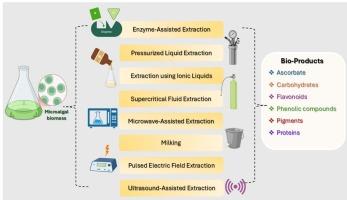微藻代谢物提取技术的进展:多因素考虑。
IF 1.9
4区 生物学
Q4 BIOCHEMICAL RESEARCH METHODS
引用次数: 0
摘要
微藻是高价值代谢物(如脂质、色素、蛋白质和多糖)的丰富来源,但其回收受到细胞壁结构复杂性和下游加工成本的限制。本文综述了先进的绿色萃取技术,包括酶辅助萃取(EAE)、离子液体萃取(ILs)、微波辅助萃取(MAE)、挤奶萃取(PLE)、脉冲电场萃取(PEF)、超临界流体萃取(SFE)和超声辅助萃取(UAE)。在这里,我们还提供了包括成本、可扩展性、提取效率和环境影响在内的多因素比较分析。结果表明,EAE和SFE获得了最高的收率(高达97% %),但受到成本的限制,而阿联酋和PEF平衡了可扩展性和可持续性,与传统方法相比,阿联酋可将提取时间缩短高达60% %。综合方法(例如,ILs + SFE,阿联酋 + EAE)显示出有希望的协同作用,提高了产量,同时减少了溶剂需求。总之,这篇综述提供了根据工业优先级选择最合适的提取策略的研究进展和见解,从而促进微藻代谢物的可持续商业化。本文章由计算机程序翻译,如有差异,请以英文原文为准。

Advancement in microalgal metabolites extraction techniques: Multi-factorial considerations
Microalgae are a rich source of high-value metabolites such as lipids, pigments, proteins, and polysaccharides, yet their recovery is limited by the complexity of cell wall structures and costly downstream processing. This review evaluates advanced green extraction techniques including enzyme-assisted (EAE), ionic liquid (ILs), microwave-assisted (MAE), milking, pressurized liquid (PLE), pulsed electric field (PEF), supercritical fluid (SFE), and ultrasound-assisted extraction (UAE). Here we also provide a multi-factorial comparative analysis incorporating cost, scalability, extraction efficiency, and environmental impact. The results indicate that EAE and SFE achieve the highest yields (up to 97 %) but are constrained by cost, whereas UAE and PEF balance scalability and sustainability, with UAE reducing extraction time by up to 60 % compared to conventional methods. Integrated approaches (e.g., ILs + SFE, UAE + EAE) show promising synergies, enhancing yield while reducing solvent demand. Overall, this review offers research advancements and insights on selecting the most appropriate extraction strategy depending on industrial priorities, thereby advancing sustainable commercialization of microalgal metabolites.
求助全文
通过发布文献求助,成功后即可免费获取论文全文。
去求助
来源期刊

Journal of microbiological methods
生物-生化研究方法
CiteScore
4.30
自引率
4.50%
发文量
151
审稿时长
29 days
期刊介绍:
The Journal of Microbiological Methods publishes scholarly and original articles, notes and review articles. These articles must include novel and/or state-of-the-art methods, or significant improvements to existing methods. Novel and innovative applications of current methods that are validated and useful will also be published. JMM strives for scholarship, innovation and excellence. This demands scientific rigour, the best available methods and technologies, correctly replicated experiments/tests, the inclusion of proper controls, calibrations, and the correct statistical analysis. The presentation of the data must support the interpretation of the method/approach.
All aspects of microbiology are covered, except virology. These include agricultural microbiology, applied and environmental microbiology, bioassays, bioinformatics, biotechnology, biochemical microbiology, clinical microbiology, diagnostics, food monitoring and quality control microbiology, microbial genetics and genomics, geomicrobiology, microbiome methods regardless of habitat, high through-put sequencing methods and analysis, microbial pathogenesis and host responses, metabolomics, metagenomics, metaproteomics, microbial ecology and diversity, microbial physiology, microbial ultra-structure, microscopic and imaging methods, molecular microbiology, mycology, novel mathematical microbiology and modelling, parasitology, plant-microbe interactions, protein markers/profiles, proteomics, pyrosequencing, public health microbiology, radioisotopes applied to microbiology, robotics applied to microbiological methods,rumen microbiology, microbiological methods for space missions and extreme environments, sampling methods and samplers, soil and sediment microbiology, transcriptomics, veterinary microbiology, sero-diagnostics and typing/identification.
 求助内容:
求助内容: 应助结果提醒方式:
应助结果提醒方式:


